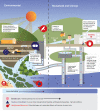Environmental reservoirs of the drug-resistant pathogenic yeast Candida auris
- PMID: 37053164
- PMCID: PMC10101498
- DOI: 10.1371/journal.ppat.1011268
Environmental reservoirs of the drug-resistant pathogenic yeast Candida auris
Abstract
Candia auris is an emerging human pathogenic yeast; yet, despite phenotypic attributes and genomic evidence suggesting that it probably emerged from a natural reservoir, we know nothing about the environmental phase of its life cycle and the transmission pathways associated with it. The thermotolerant characteristics of C. auris have been hypothesised to be an environmental adaptation to increasing temperatures due to global warming (which may have facilitated its ability to tolerate the mammalian thermal barrier that is considered a protective strategy for humans against colonisation by environmental fungi with pathogenic potential). Thus, C. auris may be the first human pathogenic fungus to have emerged as a result of climate change. In addition, the release of antifungal chemicals, such as azoles, into the environment (from both pharmaceutical and agricultural sources) is likely to be responsible for the environmental enrichment of resistant strains of C. auris; however, the survival and dissemination of C. auris in the natural environment is poorly understood. In this paper, we critically review the possible pathways through which C. auris can be introduced into the environment and evaluate the environmental characteristics that can influence its persistence and transmission in natural environments. Identifying potential environmental niches and reservoirs of C. auris and understanding its emergence against a backdrop of climate change and environmental pollution will be crucial for the development of effective epidemiological and environmental management responses.
Copyright: © 2023 Akinbobola et al. This is an open access article distributed under the terms of the Creative Commons Attribution License, which permits unrestricted use, distribution, and reproduction in any medium, provided the original author and source are credited.
Conflict of interest statement
The authors have declared that no competing interests exist.
Figures
Similar articles
-
Plastic pollution as a novel reservoir for the environmental survival of the drug resistant fungal pathogen Candida auris.Mar Pollut Bull. 2024 Jan;198:115841. doi: 10.1016/j.marpolbul.2023.115841. Epub 2023 Dec 6. Mar Pollut Bull. 2024. PMID: 38061145
-
Climate change, animals, and Candida auris: insights into the ecological niche of a new species from a One Health approach.Clin Microbiol Infect. 2023 Jul;29(7):858-862. doi: 10.1016/j.cmi.2023.03.016. Epub 2023 Mar 18. Clin Microbiol Infect. 2023. PMID: 36934871 Review.
-
Candida auris, a singular emergent pathogenic yeast: its resistance and new therapeutic alternatives.Eur J Clin Microbiol Infect Dis. 2022 Dec;41(12):1371-1385. doi: 10.1007/s10096-022-04497-2. Epub 2022 Oct 6. Eur J Clin Microbiol Infect Dis. 2022. PMID: 36198878 Review.
-
Disruption of Iron Homeostasis and Mitochondrial Metabolism Are Promising Targets to Inhibit Candida auris.Microbiol Spectr. 2022 Apr 27;10(2):e0010022. doi: 10.1128/spectrum.00100-22. Epub 2022 Apr 12. Microbiol Spectr. 2022. PMID: 35412372 Free PMC article.
-
Candida auris on Apples: Diversity and Clinical Significance.mBio. 2022 Apr 26;13(2):e0051822. doi: 10.1128/mbio.00518-22. Epub 2022 Mar 31. mBio. 2022. PMID: 35357170 Free PMC article.
Cited by
-
Interactions of the emerging fungus Candida auris with Acanthamoeba castellanii reveal phenotypic changes with direct implications on the response to stress and virulence.Microbiol Spectr. 2025 Feb 4;13(2):e0174624. doi: 10.1128/spectrum.01746-24. Epub 2024 Dec 17. Microbiol Spectr. 2025. PMID: 39688412 Free PMC article.
-
Short-term evolution and dispersal patterns of fluconazole-resistance in Candida auris clade III.mBio. 2025 Feb 5;16(2):e0316424. doi: 10.1128/mbio.03164-24. Epub 2024 Dec 27. mBio. 2025. PMID: 39727422 Free PMC article.
-
Spectrum and management of rare Candida/yeast infections in Kuwait in the Middle East.Ther Adv Infect Dis. 2024 Jul 24;11:20499361241263733. doi: 10.1177/20499361241263733. eCollection 2024 Jan-Dec. Ther Adv Infect Dis. 2024. PMID: 39070702 Free PMC article. Review.
-
Comparative Genomics of the First Resistant Candida auris Strain Isolated in Mexico: Phylogenomic and Pan-Genomic Analysis and Mutations Associated with Antifungal Resistance.J Fungi (Basel). 2024 May 30;10(6):392. doi: 10.3390/jof10060392. J Fungi (Basel). 2024. PMID: 38921378 Free PMC article.
-
Two outbreaks and sporadic occurrences of Candida auris from one hospital in China: an epidemiological, genomic retrospective study.Infection. 2025 Feb;53(1):349-358. doi: 10.1007/s15010-024-02378-8. Epub 2024 Aug 26. Infection. 2025. PMID: 39186218
References
Publication types
MeSH terms
Substances
LinkOut - more resources
Full Text Sources



